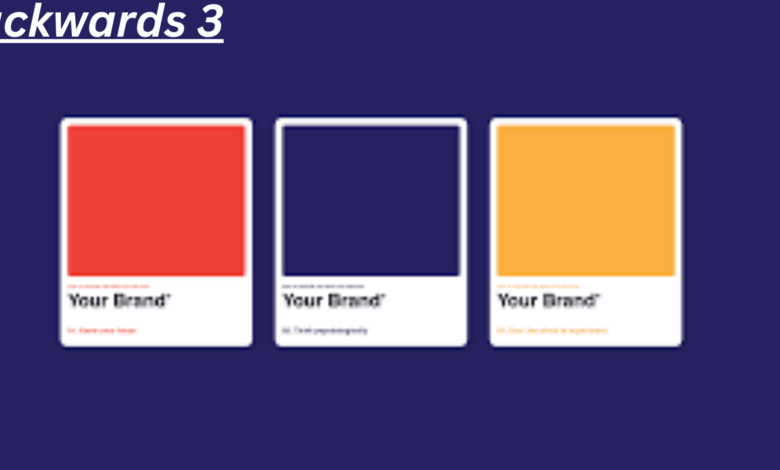Backwards 3 The Role in Creative Branding and Logos

In the vast world of branding, every detail counts. One symbol that has emerged as a bold choice in modern logos is the Backwards 3. This eye-catching twist on a familiar numeral does more than just stand out; it tells a story and invites curiosity. As brands strive to differentiate themselves in an overcrowded market, unconventional elements like the Backwards 3 capture attention and spark conversation.
But what lies behind this quirky character? What makes it so appealing for creative branding? Join us as we dive deep into the fascinating role of the Backwards 3 in logos and explore its history, psychology, and practical applications for your own brand identity. Let’s unlock the secrets behind this unique symbol together!
The History and Evolution of the Backwards 3 in Branding
The backwards 3 has a fascinating history in branding. Its unique shape captures attention, making it an effective design element for logos.
Early adopters of the backwards 3’s were often seen in niche markets. Brands wanted to stand out by breaking the mold and challenging conventional designs. The allure of this unconventional symbol resonated with creative minds looking for something different.
As time progressed, more mainstream brands began experimenting with the backwards 3’s. It started appearing in fashion labels and tech companies, reflecting innovation and forward-thinking ideals.
This evolution showcases how symbols can transcend their initial context. What began as a quirky choice transformed into a powerful statement about identity and creativity within brand narratives.
Examples of Famous Brands Using the Backwards 3
Many well-known brands have successfully integrated the Backwards 3 into their logos and branding strategies. One striking example is the popular sportswear brand, Adidas. Their iconic logo features a stylized three stripes which can resemble a backward numeral when viewed creatively.
Another notable case is the tech giant, Cisco. The company cleverly utilized a design element that resembles a backwards three in its bridge motif, symbolizing connectivity and innovation.
Additionally, some music labels have adopted this visual twist to appeal to younger audiences who appreciate unique and edgy designs.
These examples highlight how the Backwards 3 fosters memorable identities while standing out in crowded markets. Each brand demonstrates adaptability and creativity by incorporating this simple yet effective figure into their image.
The Psychology Behind the Backwards 3 and its Impact on Consumers
The Backwards 3 captivates attention in a unique way. Its unconventional shape can evoke curiosity, prompting consumers to take a closer look. This intrigue often leads to deeper engagement with the brand.
Psychologically, this symbol stands out against more traditional logos. It breaks from conformity, suggesting creativity and innovation. When brands use it, they communicate that they think outside the box.
Moreover, the Backwards 3 can stimulate memory retention. Visual oddities are easier for our brains to recall than standard designs. As such, customers may remember your brand long after seeing it.
Additionally, there’s an element of playfulness associated with the Backwards 3. Playful branding tends to foster positive emotions in consumers and enhances their overall experience with a product or service. This connection can drive loyalty beyond mere transactional relationships.
Tips for Incorporating the Backwards 3 into Your Branding and Logos
To effectively incorporate the Backwards 3 into your branding, start with a clear vision. Understand what the symbol represents for your brand. This will guide its integration into your logo.
Experiment with different styles. Play around with fonts and colors to find a combination that resonates with your audience while maintaining clarity and legibility.
Consider placement carefully. Positioning can significantly affect perception. The Backwards 3 should feel like an integral part of the design, not an afterthought.
Keep it simple but memorable. A complex logo can dilute impact. Aim for a clean design that captures attention without overwhelming viewers.
Test variations across platforms before finalizing your choice. Ensure it looks good in both digital and print formats—versatility is key in today’s multi-channel environment.
Common Mistakes to Avoid When Using the Backwards 3
Using the Backwards 3 in branding can be striking, but it comes with pitfalls. One common mistake is overcomplicating the design. While creativity is essential, excessive embellishments can detract from the symbol’s impact.
Another issue arises when brands fail to ensure clarity. If consumers can’t recognize or understand what you’re representing, your message gets lost. A simple and clear execution of the Backwards 3 often proves more effective.
Ignoring brand alignment is another error. The symbol should resonate with your overall brand identity and values. If there’s a disconnect, it may confuse potential customers.
Don’t forget about scalability. Ensure that your design retains its essence across various mediums—whether on a website or merchandise—a backward 3 should always shine through clearly and beautifully without losing its charm.
Conclusion: The Power of the Backwards 3
The Backwards 3’s has carved out a unique niche in the world of creative branding and logos. Its distinct shape grabs attention, creating an immediate visual impact that can make a brand memorable. This symbol doesn’t just stand out; it resonates with audiences on multiple levels.
Brands that have successfully utilized the Backwards 3’s demonstrate its versatility across various industries. From technology to fashion, this simple yet profound character evokes curiosity and intrigue. It invites consumers to delve deeper into what the brand represents.
Understanding the psychology behind this symbol is equally important. The Backwards 3 often breaks convention, appealing to those who value innovation and creativity. It suggests a different perspective—one that encourages exploration beyond traditional boundaries.
For businesses looking to incorporate the Backwards 3 into their branding strategy, there are key considerations for effectiveness. Balancing uniqueness with readability is crucial while ensuring alignment with your brand’s values and mission will enhance authenticity.
While it’s easy to get excited about using such an eye-catching element, careful thought must be given to avoid misinterpretation or dilution of your message through overuse or complexity in design.
Embracing the power of the Backwards 3 can elevate your branding efforts significantly when done thoughtfully and strategically. It’s more than just a number turned around; it’s an opportunity for connection and differentiation in today’s crowded market landscape.

